Vintage Scares: The Most Terrifying Short Stories Ever?
In my fourth grade year, my teacher, for reasons still unknown to me, decided to read F. Marion 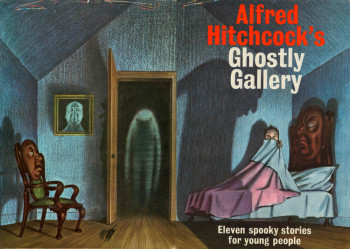 Crawford’s “The Upper Berth” aloud to our class.
Crawford’s “The Upper Berth” aloud to our class.
The story is not so well known these days, but back in the late seventies, it had gained a certain notoriety by virtue of its inclusion in Alfred Hitchcock’s Ghostly Gallery, an omnibus to which I have (with trepidation) returned to many times since. If Hitch was the source from which my teacher made her choice, perhaps she was gulled by the book’s subtitle, which read, “Eleven spooky stories for young people.”
Let me reiterate the salient feature of that rash, dangerous subtitle: FOR YOUNG PEOPLE.
Ha!
To be sure, “Miss Emmeline Takes Off” (Walter Brooks) and “The Haunted Trailer” (Robert Arthur) are easy on the soul, but how to explain the inclusion of “The Waxwork” (A.M. Burrage) or “In a Dim Room” (Lord Dunsany)?
As for “The Upper Berth,” suffice it to say that just as my teacher reached the climactic moment, our rapt, wide-eyed class erupted into chaos. One child whimpered; another screamed. Poor Alicia literally leaped to her feet and fled the room, running for dear life for the imagined safety of any spot on earth where she could no longer hear the teacher’s voice.
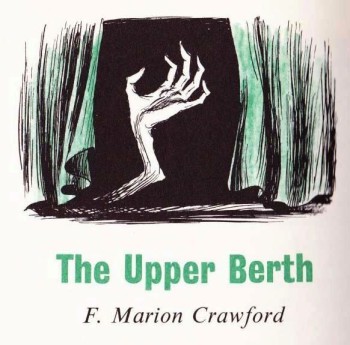 Bear in mind that this was elementary school. Think back, now. What is forbidden above all else in elementary school? That’s right. Leaving the room without a hall pass. Ah, Alicia. I remember her as a quiet, rule-bound girl. Painfully shy. Imagine the terror she must have felt to break every law she knew in order to effect her escape.
Bear in mind that this was elementary school. Think back, now. What is forbidden above all else in elementary school? That’s right. Leaving the room without a hall pass. Ah, Alicia. I remember her as a quiet, rule-bound girl. Painfully shy. Imagine the terror she must have felt to break every law she knew in order to effect her escape.
Perhaps not everyone in the room was as scarred as Alicia by our collective fourth grade “Upper Berth” experience, but I will ‘fess up to being a most unhappy camper. One thing I swore I’d never do after reading that story: take a berth on a cruise ship or ocean liner of any kind.
As an adult, I have long since broken that vow (and lived to tell the tale), but more to the point, it is time to take my revenge. It is time to maim the psyches and ruin the restive sleep of others in exchange for the wrongs once foisted on me.
How? Lean closer, gentle reader, and I’ll tell you my cunning, ill-winded plan: in six months’ time, I shall force a class of unsuspecting collegians to read Crawford’s shipboard masterpiece — it’s already on my syllabus –– and I am considering asking them to read it in the basement of the old manor home in which we shall all be installed.
Shall I ask them to turn off the lights, and illumine the page using nothing but lit candles or heavy-gauge flashlights?
Ooh, I think I should — and then let’s see how many of them manage (as I surely did not) a good night’s sleep for the next week or so thereafter.
 To this day, I would rate “The Upper Berth” as a top contender for Scariest Short Story – and I read a lot of short fiction. It has stiff competition, however, from the likes of Stephen King (“The Boogeyman”) and the writing team of Ian Rodwell and Steve Duffy (“The Penny Drops”). I also give high marks to Laird Barron (“Bulldozer”) and King again, this time with “Graveyard Shift,” collected right alongside “The Boogeyman” in his first short story collection, The Night Shift.
To this day, I would rate “The Upper Berth” as a top contender for Scariest Short Story – and I read a lot of short fiction. It has stiff competition, however, from the likes of Stephen King (“The Boogeyman”) and the writing team of Ian Rodwell and Steve Duffy (“The Penny Drops”). I also give high marks to Laird Barron (“Bulldozer”) and King again, this time with “Graveyard Shift,” collected right alongside “The Boogeyman” in his first short story collection, The Night Shift.
H.P. Lovecraft deserves a nod, too, primarily for “Pickman’s Model,” a story that I must note is roundly despised by none other than Joyce Carol Oates, who certainly knows her way around horror (and gothic in particular). Nonetheless, the story gets me every time. Possibly, as with “Graveyard Shift,” I have a problem with oversized rodents? Or at least a weakness for basements, for cellars? The latter, certainly. Only now, well past my quaking twenties and my leery thirties, do I dare enter tunnels, wells, caves, or any other labyrinth of darkness that hints of recesses beyond my immediate knowledge. Who knows where they might end? Who knows, if I did venture inside, where I might end?
“Only the Young,” by Josh Rountree, isn’t exactly scary, but it deserves mention because it’s a high-octane example of a story where I truly didn’t want to turn the page – I really didn’t want to let myself in for the stomach-churning violence that I absolutely knew was coming. (This is a tough story to find, which I know first-hand; Rountree’s tale and one of my efforts, “Called On Account,” both found print in Shadow Regions, an ill-fated anthology where the publisher absconded with the money and left the book to die without promotion or support. (Yes, Virginia, the writing life can be hard. Happily, “Called On Account” later got picked up by Tales To Terrify, a podcast archive. Episode #33, to be precise.)
The longer and more diverse my list became, the more curious I became about the opinions of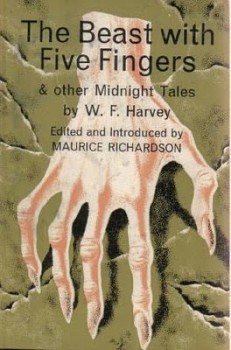 others. I queried a few editors and friends, and was surprised both by the diversity of their choices and also by the repeated mention of two stories in particular, “The October Game” by Ray Bradbury and “The Clock” by W.F. Harvey.
others. I queried a few editors and friends, and was surprised both by the diversity of their choices and also by the repeated mention of two stories in particular, “The October Game” by Ray Bradbury and “The Clock” by W.F. Harvey.
“The Clock” got a recent shout-out on this very site, and both John O’Neill and Howard Andrew Jones (The Bones of the Old Ones) mentioned this as a worthy contender.
It’s certainly a curious piece. British to a fault, it’s an epistolary tale, oh-so-tidy-and-traditional, but also somewhat vague. Nothing bad actually happens. Nor will it. What chills the story delivers are engineered entirely through Harvey’s clear understanding that fear, once given its head, breeds more fear, and quickly, too. (President Roosevelt also knew this, also Frank Herbert.) Harvey toys with the reader, with the reader’s sense of dread experience, one’s willful (and downright unhelpful) desire to be frightened.
As for “The October Game,” this is Bradbury at his most brutal. Think “The Veldt” or “The Small Assassin,” and then multiply times ten. It’s also predictable. Is one of the mechanisms by which primal terror may be delivered a cold certainty that you know precisely what is happening, and that the implacable, unstoppable results will be ghastly? Mr. Rountree would certainly concur.
Editor Joy Crelin, just now in the process of launching Betwixt, a new spec fic venture, cites Lovecraft, specifically “The Rats in the Walls.” Crelin notes the clear separation between the fright implicit in Lovecraft –– the unknown –– and the more everyday scares evinced by (among others) Richard Matheson’s “Duel.” In that story, an otherwise unremarkable driver is menaced, for no apparent reason, by a malicious big rig truck.
As Crelin puts it, “‘Duel’ is so unsettling for me because it taps into one of my more realistic fears.” Makes perfect sense; who hasn’t had the experience of driving alongside an eighteen-wheeler only to realize that in a heartbeat, those massive tires could crush the entire vehicle in which you sit?
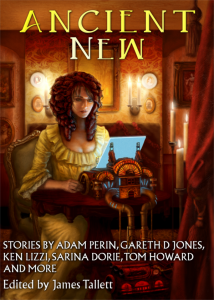 Deepwood Publishing’s James Tallett also mentioned Lovecraft, although the one that stayed with him down the years, “The Dream Quest of Unknown Kadath,” he identified as less overtly terrifying and more “dark fantasy and weird.” “Imagine,” he explains, “one of Lovecraft’s other stories, but without the protagonist going insane and being eaten at the end.”
Deepwood Publishing’s James Tallett also mentioned Lovecraft, although the one that stayed with him down the years, “The Dream Quest of Unknown Kadath,” he identified as less overtly terrifying and more “dark fantasy and weird.” “Imagine,” he explains, “one of Lovecraft’s other stories, but without the protagonist going insane and being eaten at the end.”
Poet and tale-spinner Claire Cooney, two of whose stories can be found here at Black Gate, settled on one story and one story only: Shirley Jackson’s “The Witch.”
Her assessment? “Made me hyperventilate in my friend Stephanie’s kitchen. Short, but wham.”
Not being conversant with this particular Jackson effort, I scurried off to find a copy. My assessment? Short, yes. Wham, yes. Ah, but I do love me some Shirley Jackson.
Writer and editor Dallas Woodburn also cited Jackson, especially “The Lottery,” which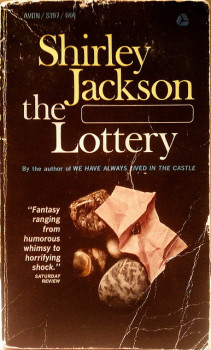 happens to also be a personal favorite of mine. (Of course, I’d trust Woodburn’s judgment even if I didn’t share her taste; as a finalist for the 2012 Flannery O’Connor Award for Short Fiction, she clearly knows her way around short-form storytelling.)
happens to also be a personal favorite of mine. (Of course, I’d trust Woodburn’s judgment even if I didn’t share her taste; as a finalist for the 2012 Flannery O’Connor Award for Short Fiction, she clearly knows her way around short-form storytelling.)
For those who haven’t read it, “The Lottery” is in a distant way related to Matheson’s “The Duel,” referenced above. It’s a piece born of Cold War paranoia, of the creepy, deep-rooted certainty that something in society – in humanity – has gone terribly wrong.
Unlike, say, Lovecraft, there aren’t any monsters. Jackson, at least in this story, doesn’t need them. As with the current zombie craze, she knows we’re already surrounded.
Finally I went to John Hocking, a Black Gate veteran and author of Conan and the Emerald Lotus. His take: “From the English ghost story genre I’d pick H. Russell Wakefield’s “Red Lodge” and M.R. James’ “Oh Whistle and I’ll come To You, My Lad” as maybe the scariest.”
In referencing “The Clock” (See? Everybody loves “The Clock”), Hocking cited its astonishing “power-to-weight ratio. It’s four pages long and hits you with maybe the fiercest blast of ‘What in the name of God is that?’ in fiction.”
For a contemporary piece, he selected Michael Shea’s “The Autopsy.” “Creeped me out as badly as anything I ever read. Most ghastly creature ever put on the page.”
Now, I really must stop. Time to dust off Alfred Hitchcock’s Ghostly Gallery and re-familiarize myself with Mr. Crawford’s “Berth.” How many years has it been? I don’t even want to think.
 Anyway. Wish me luck. Especially later, when I crawl between the (probably haunted) sheets.
Anyway. Wish me luck. Especially later, when I crawl between the (probably haunted) sheets.
In the meantime, leave a comment. Which short stories put dents in your peace of mind? I do look forward to hearing your suggestions!
Also: check back in two weeks. My next offering here will cover some of my own entries in the horror field (including a thought or two on “The Trade,” from these very pages), and my squeamish dismay at discovering that I am, in fact, a writer of horror fiction.
‘Til next time.
Dream hard.
Write harder.
Mark Rigney has published three stories in the Black Gate Online Fiction library: “The Trade,” “The Find,” and “The Keystone.” Tangent called the tales “Reminiscent of the old sword & sorcery classics… once I started reading, I couldn’t stop. I highly recommend the complete trilogy.”
Let’s see — encountering Yours Truly, Jack the Ripper in, as I recall, some Alfred Hitchcock anthology. And for Lovecraft, for me it’ll always be the Colour Out of Space.
Hi Joe – “Yours Truly, Jack the Ripper” is Robert Bloch, and was adapted to radio and TV. Boris Karloff “hosted.” And Bloch re-used the immortal Jack concept for “A Wolf in the Fold,” one of the really entertaining STAR TREK scripts. (“Die, die, everybody die!”)
I’ve never read the novel PSYCHO, but Bloch was the writer there, too.
Oh, and did you know? Bloch was mentored by (drumroll) H.P. Lovecraft!
Yep — a Bloch story in another one of those Hitchcock Presents anthologies aimed squarely at young readers. Because the publisher clearly hated young readers and wanted to scar them for life.
And I remember finding it really cool when I learned who “Robert Blake” was in Lovecraft’s Haunter of the Dark, and then going on to read the Bloch story (whose name escapes me) to which Lovecraft was responding.
“The Upper Berth” is a great one! I think I read it as a classic reprint in an issue of WEIRD TALES.
I agree with the following choices as super scary: “The Upper Berth,” Bradbury’s “The October Game,” and Jackson’s “The Lottery.”
I’d also suggest the following: Anything by Laird Barron! I especially like “Hallucigenia.” Any short story by T. E. D. Klein: “The Events at Poroth Farm,” “Black Man with a Horn,” “Petey,” or “Nadleman’s God.”
Have you ever read the Lovecraft story “The Curse of Yig”? It was a collaboration with someone else, but most of the story is Lovecraft and it is quite scary.
I could go on and on.
“Don’t Look Behind You” by Fredric Brown in ALFRED HITCHCOCK PRESENTS: STORIES NOT FOR THE NERVOUS, in a second-hand paperback edition given to me by my uncle when I was around fourteen or so. Arguably a gimmick story, but like so many Brown stories the gimmick was so clever it was executed so smoothly as to be utterly convincing. Brown will make you believe that an insane killer is hiding… well, you should read the story!
I second McGlothlin on “The Events at Poroth Farm” by T.E.D. Klein. If you haven’t read it yet, go ahead. You’ll thank me later.
And for something really different (and surrealistically disturbing), check out some Thomas Ligotti from the past fifteen years or so. Take in small doses: his nihilistic portrayal of the world as a mad puppet show orchestrated by an insane and malevolent universe is unsettling (and really, really frightening on a basic existential level).
Arthur C. Clarke’s “A Walk in the Dark.” Totally forgot to mention that one when you asked, Mark!
Oh, how my childhood was twisted by a bedtime reading of Theodore Sturgeon’s “The Professor’s Teddy Bear”…
I am delighted to discover that virtually every reader of this post (or at least those who have left comments) has been reading LATE AT NIGHT. Spooky spooky spooky…
And I am equally delighted to hear of new stories of which I was previously unaware. I adore the Sturgeon title: “The Professor’s Teddy Bear.” That’s GOT to be spine-tingling.
Remind me to tell you all about the night I watched CHUCKY, then slept in a bed in a house not my own in which the lamp was, I kid you not, done up like a marionette clown. And then in the middle of the night, when the phone rang, and I reached over to flick on the light…?
[…] at identifying a handful of the most hair-raising, spine-tingling short fiction ever written (in Vintage Scares). The more I looked at the stories that I (and others) came up with, the more excited I became […]
Hmm, super scary?
Ok, here’s my list.
As a kid ca. 1971
Hodgson’s „A Voice in the Night“
Derleth’s “The Dark place”
Seabright’s (Mary Elizabeth Counselman) “The Man who sold Rope to the Gnoles”
Brennan’s “Slime” and “Levitation”
Goodwin’s “The Cocoon”
Anything from Scholastic by Bernhardt J. Hurwood
As an adult?
Octavia Butler’s “Blood Child”
Dan Simmons’ “Song of Kali”
There are so many others that are incredibly horrifying and/or terrifying. That’s easy to do though.
It’s being “scary” that’s hard”.
Take care.
Doug
[…] Vintage Scares: The Most Terrifying Short Stories Ever? […]
[…] But I don’t think you should have to take my word on it. Here’s the distinguished Mr. John Hocking, whose taste in fantasy fiction as we know is impeccable, with a two-sentence review of “The Autopsy,” as quoted in Mark Rigney’s 2013 article “The Most Terrifying Short Stories Ever?” […]
[…] Upper Berth,” a trans-oceanic spookfest from 1896 that I’ve mentioned before (HERE), drew similar enthusiasm: three ratings of one, two ratings of two, and an outlier who hated it or […]
Can anyone tell me why the Upper Berth is considered so scary? October Game, unnerving, the Clock weirdly chilling agreed, the Upper Berth… I don’t get it.
THE UPPER BERTH and GHOSTLY GALLERY itself are both fine works of their respective ilk, but another Hitchcock anthology, MONSTER MUSEUM, did me in with a few tales that got me even harder than the Crawford classic:
SLIME – Joseph Payne Brennan
THE DESRICK ON YANDRO – Manly Wade Wellman
THE DAY OF THE DRAGON – Guy Endore
And
DOOMSDAY DEFERRED – Will F Jenkins (aka Murray Leinster)
Looking for a vintage short story, a horror radio broadcast sets up in a haunted house, has himself chained. HIs crew leaves the house and listens to the broadcast from the van that sends out the signal. Story is very scary and after it ends, the host tells the crew to hurry up and come back and get him as he hears something…
Susan B.– Sounds like you mean “The Believers” by Robert Arthur, which I just learned was based off of H. Russell Wakefield’s “Ghost Hunt.” There’s a version of “The Believers” available on the Scary For Kids website, if you were looking to read it again.